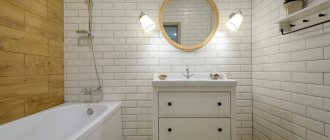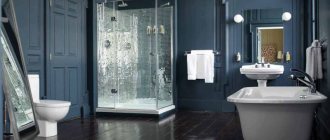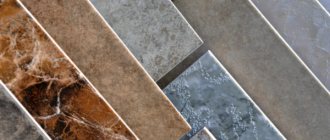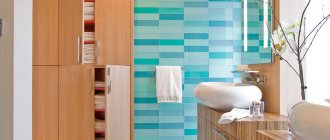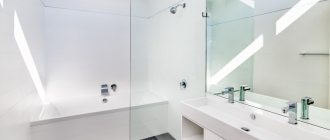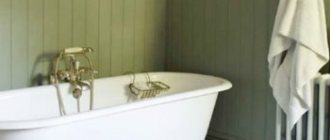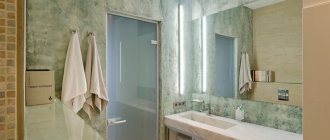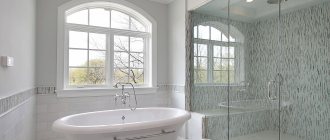Selection of finishing material
Next you need to calculate the required number of tiles. This procedure is extremely simple and useful, as it will help to avoid waste of material during finishing work.
First of all, you need to determine the perimeter of the floor surface in the bathroom. To do this, measure the length and width. Then you need to multiply the obtained indicators. After this, you need to find out the tile parameters. To determine the quantity of tiles required, you need to divide the perimeter of the bathroom by the parameters of the tiles.
For a wall surface, the amount of material is calculated as follows: you need to determine the area of all four walls by subtracting the area of the door. Then you should add the resulting values and divide by the area of the tile.
Durable, wear-resistant and moisture-resistant boards are used to decorate bathrooms. The blocks are used in the design of walls, floors, and ceilings. The composition of the slabs differs. The blocks are produced in porcelain stoneware, ceramic, and glazed.
The use of ceramic tiles for a small bathroom provides:
- long service life of finishing;
- easy care;
- moisture resistance of materials;
- simple installation and repair;
- wide possibilities when choosing a design project (the slabs are presented in a variety of colors, sizes, textures).
The disadvantage of the material is cold surfaces; for flooring it is recommended to create a heated floor system. Before applying the slabs, it is necessary to level the walls and create a floor screed.
When determining the size of slabs for a compact bathroom, it is necessary to perform a calculation and draw a diagram.
The use of large blocks divides the room into zones, reducing the size of the space. Ornaments with large patterns are not suitable for a small bathroom. It is optimal to use medium-sized slabs. For square blocks, the recommended dimensions are 20x20 cm, for rectangular blocks - 20x30 cm.
The surfaces of the slabs, depending on the treatment, are available in glossy, matte or mirror finish.
Blocks with a glossy sheen reflect light, are easy to clean, and come in bright colors. For compact rooms, slabs in light or rich colors are optimal. Dark blocks will visually make the room smaller.
Matte elements can be combined with glossy ones. The surfaces are easy to clean and do not reflect light. The material is optimal for floor coverings, because... has textured surfaces. Imitations of wood, stone, and metal surfaces are original.
Mirror plates allow you to visually enlarge the space; in a compact bathroom they are used as inserts and collages. Horizontally placed mirror tiles increase the depth of the room. When finishing the ceiling, the elements will increase the height of the room.
Interesting ideas for the interior
Marble tiles can be used to decorate any bathroom. It will fit especially well into the interiors of the following styles:
- classical;
- antique;
- rococo;
- baroque;
- retro;
- art deco;
- minimalism;
- eco.
Classical
White, gray or beige marble is suitable for such an interior. It is better to choose tiles with veins - this design is ideal for classics. The floor can be made plain light, or you can combine white tiles with black ones. This combination is always rich and interesting.
For a small bathroom, choose light glossy or semi-gloss tiles - they will make the room seem more spacious. Part of the wall will be decorated with a panel of figured tiles - its boundaries can be indicated by a golden frame. A white bathtub and copper or gold-plated sanitary ware will suit a classic interior. If space allows, you can install a stone countertop in a contrasting color for the sink - brown, black, dark green.
Antique
To create a truly antique interior, use white or beige marble with gold veins. It is suitable for walls, but for the floor it is better to choose tiles with a round pattern. It can decorate every tile or be on only two or three. The flooring should “echo” the walls, so the pattern should also be gold.
A distinctive feature of the antique style is columns and stucco. You can make a decorative column in the bathroom - against the background of marble it will look especially elegant
One of the walls can be decorated with stucco, but it is important to choose the right material. For example, gypsum will not withstand high humidity and will crumble
https://www.youtube.com/watch?v=mKsi51bhKP8
Pick up a mirror in a gold frame, candle lamps and a couple of figurines of Greek goddesses, and the interior will be complete.
Baroque and Rococo
The bathroom will have a lot of gold, stucco and crystal. White, pink and beige marble will fit into such an interior. Large black tiles are suitable for the floor. You can use tiles of the same color to lay out a design on the wall. The use of mosaics is also encouraged. Small tiles can be used to decorate the outside of the bathroom, the countertop, and the space around the mirror. In a large room, you can hang a crystal chandelier from the ceiling; for a small room, choose original lamps.
Here you need to choose what kind of retro style the interior will be made in - marble is not always suitable. It is relevant if you make a vintage bathroom, in the style of the 30s, for example. For the later period, the use of natural stone was not typical.
In retro interiors, white marble tiles are often placed on the floor, in a checkerboard pattern with black or gray. You can also lay out an apron near the bathtub, and put washable wallpaper on top.
Art Deco
This style breaks stereotypes and allows you to combine the incongruous. For such interiors, they came up with a bright palette of marble tiles. You can use black, red, blue, brown tiles in the design. An all-black bathroom is truly Art Deco.
We suggest you familiarize yourself with How to install a toilet and bathroom door
In such interiors, they often make a checkerboard black and white floor, decorate the room with a large crystal chandelier, plants in large pots, and a mirror in a wide frame.
Modern
Art Nouveau is characterized by restraint and brevity. Marble can be used to decorate a bathroom in this style, but it should be dim. Gray, white and light brown are best. There will be no unnecessary objects here, so the marble wall will become the semantic center and the main decoration of the room.
Minimalism
A minimal amount of details, furniture, decor and colors are the main features of this style. But even with such restraint in everything, the interiors turn out to be rich and sophisticated. To achieve true minimalism, it is better to use natural-colored marble - white, gray, and black. Red, green, blue colors are not suitable for such interiors.
Only natural materials are used here. For walls and floors, choose natural stone or artificial stone that imitates it. Dull marble will fit very organically into an eco-friendly bathroom. It will go well with natural wood, glass, and green plants. Such rooms are decorated in a restrained color scheme - bright, glossy tiles are not suitable for such rooms.
It is not necessary to finish the bathtub with stone from floor to ceiling. Sometimes just a few details are enough for the natural elegance of the stone to add sophistication to the room. As practice shows, products made of marble and marbled are always appropriate and look great.
In addition to tiles, various pieces of furniture, decorative items and structural elements can be made from marble
It is made from both natural and artificial stone. Combines beauty and practicality. Countertops made of artificial marble are lighter than natural ones, most of them are made using seamless technology, and therefore are not afraid of mold and mildew.
A countertop made of marble chips will effectively decorate a bathroom and give the interior an aristocratic charm.
Marble countertops are practical and luxurious
A marble countertop will be an excellent complement to ceramic tiles of various textures and colors.
Another now popular use of this material. This sink is a worthy replacement for traditional stainless steel. It looks expensive and presentable, and can transform the entire bathroom.
Plumbing products made from cast marble allow you to equip your kitchen with beautiful products
Such sinks are durable and are not susceptible to corrosion. If damaged, they lend themselves well to restoration: the broken piece can be glued back, scratches can be rubbed out.
A marble sink can be matched to any interior style
The disadvantages are the same as those of marble tiles - high cost, weight and high maintenance requirements.
When choosing decor and furniture made of marble, it is worth remembering that the material requires special attention
When using marble cladding, the ideal solution is to choose a classic style bathroom. In addition, it is permissible to use marble tiles not only on the wall surface, but also on the ceiling and floor surfaces. Decorative details look great on countertops under the washbasin and various shelves.
A country style interior (even if it is an artificial analogue) will fit perfectly into the bathroom concept. Light shades of marble and wood-like veins will perfectly match the chosen style direction of the bathroom. Marble finishes are also appropriate in retro-style interiors. To do this, you should give preference to light and brownish shades and the color scheme inherent in mahogany.
Marble bathroom color scheme
The theme of marble color deserves special attention.
The color of marble determines its functional purpose and quality characteristics
There are three types used in finishing:
- White. It is most often used in decoration. Alone or in combination with other materials - mosaics, ceramic tiles, marble of other colors. It adds tenderness to the atmosphere, visually expands the space, and adds light. As a rule, it has inclusions of gray, pink, and brown shades.
- Grey. It has more pronounced veins of a darker shade, sometimes almost black. Looks great both on its own and in combination with other materials. Multicolor or multicolor. Here we are talking only about artificial stone. It is used more often for making countertops or as a decorative detail. The color palette is huge.
- Black. Unrealistically beautiful. Has white or golden veins. It is better to use it as decor so as not to make the atmosphere too gloomy.
Relief and ornament: creative and stylish
Large reliefs on the slabs and inserts of geometric patterns are original and aesthetically pleasing, but when decorating a small bathroom, proportions must be observed. Large panels and voluminous relief inserts are not recommended.
You can include patterns in delicate shades on medium-sized slabs in the masonry.
It is allowed to include a small mosaic installation to create accents in the room and expand the space. In modern designed bathrooms you can use slabs with a 3D image.
Disadvantages of marble tiles in the bathroom: high price and maintenance
If the apartment owners decide to decorate the bathroom with natural marble, you need to know about the disadvantages of this material.
You should not choose marble for finishing your bathroom if your renovation budget is limited.
The high cost has already been mentioned. We can only add that the most expensive will be cladding from large slabs and the use of rare varieties of stone for this (for example, the difference in the price of ordinary white and blue, which can only be mined in a few mines in Argentina, varies tenfold).
The disadvantage may be the porosity of this natural material. Of course, the walls will breathe, but moisture, chemicals, and dirt will also be better absorbed. Before installation, stone slabs are polished and treated with protective solutions, but one small chip negates the protection.
For all its grace, marble is a rather fragile and whimsical material.
Caring for natural finishes is not so easy. Natural stone is sensitive to aggressive chemicals, such as chlorine and acids. Read the composition of chemicals carefully. Even a small amount of any acid can damage the coating. Marble cannot be cleaned with abrasives.
Marble tiles combine perfectly with various materials
What wood and marble look like in a bathroom
The combination of noble stone with equally noble wood will give the interior a unique sophistication.
Open shelves or closed cabinets can be made of wood. Wood can be a decorative element - a massive wooden frame will harmonize well with the same bath screen and furniture.
Wood and marble are two natural materials that look great in tandem
Wood and marble in the bathroom can be matched in the same color scheme. The combination of walls in warm colors with the color of natural wood in the design of details will create a unique atmosphere of comfort.
When using marble and wood in the bathroom, you can, on the contrary, play on the contrast. The warmth of dark wood will set off the cold stone and add refined notes to the monumental “stone” interior.
A successful combination of wood and marble in bathroom design
Using this stone in interior design is undoubtedly the right decision. Thanks to its unsurpassed properties and texture, it will undoubtedly allow you to achieve the design of your dreams, turning the most standard bath into a place of relaxation and relaxation. And you will feel like you are in a fairy tale.
Color palette of marble tiles for the bathroom
For owners of small bathrooms and toilets, a more careful selection of materials is required. In order to visually create a spacious and comfortable room, you need to have an idea of the richness of the color scheme and the texture of the material. Light colors visually expand the space, making it more spacious.
Therefore, when purchasing, you should pay attention to marbled tiles made in white, beige, blue, pink, light gray or light brown shades. To give the bathroom a warm and cozy atmosphere, you should choose terracotta, orange, beige or pink, while blue, gray and green colors will do a great job of creating a cooler and more peaceful atmosphere.
An original solution would be to design the wall and floor surfaces in the same color shade and texture. This option perfectly smooths out corners and adds extra space to the room. Contrast between the wall surface and the floor surface should be avoided. Visually, the room begins to seem smaller than it actually is. In addition, you should not focus on the corners.
Popular color palettes for a compact room:
- neutral (gray, lilac, white, pink);
- warm (beige, golden, yellow, sand, peach);
- cold (purple, blue, light blue, pistachio).
We invite you to familiarize yourself with Wall decoration with linoleum in the bathroom
The use of a burgundy shade allows you to implement original design ideas in the classic, baroque, and modern styles. In a compact room, it is necessary to maintain proportions and complement the bright colors with a neutral palette (beige, white). In finishing, details with bronze coating and gilding are optimal.
Classic interiors are decorated with white and milky slabs with the inclusion of rich burgundy tones. It is allowed to install elegant golden ornaments in the decoration of the floor or walls.
Pastel palette
https://www.youtube.com/watch?v=
The optimal solution for designing a small bathroom with tiles is to use elements in pastel colors (pale lime green, dusty pink, blue). The palette of plates can be cold or warm. Pastel colors help visually expand the room and create a feeling of spaciousness. Delicate colors are popular in country, minimalism, vintage, and Provence styles.
Peach, beige, vanilla, pink, coffee shades will create an atmosphere of comfort and warmth in the ladies' bathroom.
For a neutral palette, it is necessary to create color accents (turquoise, rich pink), and organize additional lighting in the functional areas above the sink and in the shower.
When using rich colors in a compact bathroom, you need to choose neutral colors as the background. A winning option for decorating one wall in a bright color (orange, purple, green). The walls are original, decorated with red slabs with the addition of olive and white blocks.
Orange shades can be complemented with green, light gray, dark blue colors. For high-tech design rooms, a combination of rich orange and white is used.
The combination of peach, cream, beige, and apricot colors looks original. Shades create a comfortable environment in the bathroom.
For compact baths, it is optimal to use delicate shades (milky, soft golden, ivory). The finishing is complemented by slabs with accent details in the form of relief and subtle ornaments. Accents help create slabs with a rough texture like light wood, marble, or stylized aged surfaces. You can include blocks with decoupage in a bright bathroom in the Provence style.
Sand tones
The sand color scheme allows you to create a warm atmosphere in the room and visually expand the space. It is possible to use blocks of different golden shades. One wall is decorated in an original way with tiles with a rough sand-colored texture. The seams are filled with light-colored grout. Accents in a monochrome interior will allow you to create gold-plated or chrome-plated parts (fittings, shelving).
Traditional colors
Traditional colors are used in classic rooms. A combination of brown shades (chocolate, beige, sand, terracotta, golden, vanilla) and neutral pearl and white looks stylish. The finishing uses monochrome blocks or with imitation wood textures (wenge, stained oak, birch, maple).
Blue shades are combined with silver and white colors, creating a feeling of expansion of space. Marine style is harmonious for small rooms.
The color of real marble without inclusions or veins is white. Tiles in this color are popular and are often used for decoration. It looks discreet and luxurious, especially in combination with black tiles.
The color palette also includes gray marble. It comes in different shades - it all depends on how many foreign impurities are added to the material. The more there are, the richer the gray color. Due to this composition, this tile is more durable. It is resistant to any mechanical stress, moisture, and sudden temperature changes.
Designers have come up with more shades of marble than nature. Granite chips of different colors are added to the composition, and blue, red, brown, pink and green marble are obtained. The choice is so rich that the material can be used in interiors of different styles, not just classic ones.
White marble effect wall tiles for a classic style bathroom
The color of this natural natural marble affects its structure and characteristics. The white stone in the decoration is simply luxurious. But it is also the softest. Making a countertop or floor out of it is not the best option. And it is perfect for walls, bathtubs or sinks.
Marble has always been in demand in the design of palaces; in our time, this natural stone dictates the overall concept of the classical style.
Shape and structure of marble tiles
Her choice now is simply huge - so many different colors, textures, shapes! Such tiles will suit any style - from elaborate baroque to ultra-modern high-tech. But traditionally, marble walls are associated with classical design.
For small rooms, medium-sized tiles and light colors are best.
White stone contains the least impurities and is considered the most delicate and luxurious
The safest option is to use beige or white colors. This will visually expand the room. Manufacturers offer both glossy and matte tiles. A glossy surface looks richer. It reflects light better, visually enlarging the space, adding air and light to the room.
Gray marble is rougher in nature due to impurities, but in appearance it is not much inferior to white stone
If walls made of solid white marble seem boring, then you can use inserts made of figured slabs (non-standard shape, with rounded corners). It is more difficult to put on the wall and leaves a lot of waste. But there is no need to lay all the walls from floor to ceiling with such tiles - this is overkill. It is enough to make small inserts. This will diversify the design of the marble bathtub. Stones of neutral colors can be combined with bright contrasting inserts. A bathroom with white marble walls combined with a dark floor and a mirror in a beautiful frame looks elegant.
Colored stone contains even more impurities, which is why it has a rich palette of shades.
Texture and size
For a small bathroom you need to use glossy light tiles. This solution, in the presence of high-quality lighting, will create a beautiful and luxurious design for the bathroom, which will be bright throughout the day.
For those who do not like glossy surfaces, there is an alternative in the form of semi-gloss cladding materials. For the floor surface in this situation, it is recommended to use marble-like tiles with a rough surface. It is desirable that it matches the shade chosen for the wall surface. The anti-slip coating promotes safe movement, eliminating the possibility of slipping.
A wide range of marble tile sizes available allows consumers to choose a material that will meet all their requirements. In a small room, the best solution would be to use small or medium-sized tiles. A large tile size, on the contrary, will visually make the bathroom smaller than it actually is.
Caring for small tiles is much more difficult than caring for larger tiles. Nevertheless, the bathroom or toilet will look more attractive in appearance. It is recommended to choose tiles in light shades. Specks of dust, dried splashes and stains from a cleaning or washing solution will remain invisible on a light-colored surface, and mechanical damage (scratches, cracks or chips) on a wall or floor surface can be masked using colorless varnish. You can try using an adhesive or grout, the color of which will match the surface being treated.
We suggest you familiarize yourself with the pressure switch of a washing machine: what it is, how to check, replacement
According to the texture, marble tiles can be of three types:
- matte;
- glossy;
- semi-gloss.
Matte
The big advantage of matte tiles is that they do not require frequent cleaning. It absorbs light, due to which splashes, stains, wool, and dust particles are not visible on it. Small scratches remain unnoticeable on the matte surface, so it is better to lay this kind of tile on the floor. This coating is ideal for the bathroom because even if water gets in, it does not slip.
Manufacturers offer tiles with varying degrees of porosity. If there are too many small holes on the surface, it is difficult to clean. Over time, dirt may become embedded in such tiles, and they will develop a grayish tint.
Glossy
These tiles are recommended for small bathrooms. Due to the fact that light is reflected from the glazed surface, the space visually expands. With glossy tiles, the interior seems brighter and “juicier”. Glossy marbled tiles in black and green colors look impressive.
This material also has disadvantages: the surface is highly slippery, and small scratches and chips are very noticeable on it. This tile is easy to clean, but it needs to be done often, because any dirt on it is clearly visible.
Semi-gloss
If both of the previous options do not suit you, buy semi-gloss tiles for the bathroom. It is slightly shiny, but has a rough surface. This tile does not get dirty as quickly as glossy tiles, but it also does not require frequent washing. It is suitable for both walls and floors of any style interior.
Why should you choose marble?
- Marble is an environmentally friendly material.
- Durable and easily withstands all mechanical stress.
- Will last for many years.
- It has excellent thermoregulation and is not afraid of moisture.
- Easy to clean from dirt.
- Marble comes in a variety of colors and textures.
The only disadvantage of this material is its price.
Marble in the bathroom interior
Marble in the bathroom interior
Marble in the bathroom interior
Marble in the bathroom interior
Marble in the bathroom interior
Marble in the bathroom interior
Deciding on the layout
Experts do not recommend using complex tile laying technologies in a small bathroom. By placing the slabs staggered or diagonally with a row offset, you can expand the floor space. Rectangular blocks must be laid vertically; this method will visually raise the ceiling. Horizontal laying will lengthen the room.
Seam to seam
Placing slabs “seam to seam” is a simple scheme that can be used for floor surfaces and wall decoration. The direction of the rows should be parallel to the lines of the room. It is necessary to check the accuracy of laying on vertical planes using a plumb line, and on horizontal planes using a triangle. To implement the scheme, slabs in the shape of rectangles or squares are used.
When laying “seam to seam”, a small consumption of construction raw materials is required. The method is easy to implement on solid planes. It is allowed to include ornaments and small panels in plain masonry. During installation, it is necessary to use special fasteners to create smooth connecting seams.
Diagonal
Laying tiles diagonally in a small bathroom increases the space, but requires more blocks, glue and putty. When implementing the scheme, it is necessary to level and trim some of the slabs to make even joints. The symmetry of the arrangement of the blocks is checked using a building level and a triangle. Laying allows you to visually correct uneven walls and expand the space of a small bathroom.
In the dressing
The method of laying slabs “in a bandage” is similar to a standard brick wall. When implementing the method, rectangular slabs are required. The color palette should be monochrome or with a combination of shades of the same range.
The formation of rows is carried out horizontally, joining elements vertically narrows a small room. The advantage of the method is the possibility of using blocks with a slight difference in size.
Modular
The modular technique of laying tiles involves the use of more than 3 sizes of blocks to create an original ornament or artistic image. It is possible to create a geometric pattern and arbitrary arrangement of elements. For a small room, monochrome surfaces with decorative inserts are optimal.
Laying blocks using the mosaic technique allows you to create complex patterns and artistic images on surfaces. Drawings that reproduce the ornament of a carpet with a border around the edges, or the laying of single-color slabs with a graphic or multicolor image in the center look original.
It is possible to combine 2-3 ornaments on the wall. The remaining surfaces should be plain to visually expand the space.
When implementing the method, it is necessary to purchase a supply of blocks up to 15%. When drawing up a scheme, you can use different textured coatings and combine shades. Installation of elements is possible on curved planes of the bathroom.
Color solutions
When implementing a project, you can use ready-made interior design ideas. The combination of 3 types of slabs when finishing surfaces looks original; medium-sized rectangular blocks, square elements and mosaic masonry are used. Shades must correspond to the chosen style and tonality of the scale. When implementing schemes, it is necessary to take into account the equipment of the bathroom.
When placing a bathroom and a toilet separately, it is recommended to choose the same stylistic direction for the premises. The color scheme of the rooms must match, and plumbing fixtures are selected from the same collection.
To visually expand a room with a bathroom, slabs with glossy surfaces, mirror mosaics, and large mirrors are used to decorate one wall. It is possible to decorate the surface with artistic mosaic tiles made of glass or smalt.
To increase the space, floor slabs are mounted diagonally, wall panels are decorated with horizontal stacking of blocks and friezes. The horizontal strip is located 80-90 cm from the floor.
Combined bathroom
When decorating a combined bathroom and toilet, it is necessary to create different accents in the functional areas while maintaining a single color scheme. When creating an interior in light colors, it is not recommended to use only white slabs; it is possible to include gray, pastel, milky shades. The bright room is complemented by artificial lighting on the ceilings.
A compact bathroom with a square configuration will be expanded by vertical laying of rectangular blocks. Finishing can be done on walls and floor surfaces. A bathroom decorated with slabs of blue shades can be complemented with marble inserts or blocks with imitation stone.

